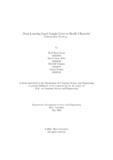| dc.contributor.advisor | Alam, Md. Golam Rabiul | |
| dc.contributor.advisor | Reza, Md. Tanzim | |
| dc.contributor.author | Iqbal, Syed Bayes | |
| dc.contributor.author | Rifat, Riazul Islam | |
| dc.contributor.author | Hussain, Md Akif | |
| dc.contributor.author | Biswas, Simon | |
| dc.date.accessioned | 2022-12-12T09:25:18Z | |
| dc.date.available | 2022-12-12T09:25:18Z | |
| dc.date.copyright | 2022 | |
| dc.date.issued | 2022-05 | |
| dc.identifier.other | ID: 18101198 | |
| dc.identifier.other | ID: 18101236 | |
| dc.identifier.other | ID: 18101073 | |
| dc.identifier.other | ID: 18101543 | |
| dc.identifier.uri | http://hdl.handle.net/10361/17636 | |
| dc.description | This thesis is submitted in partial fulfillment of the requirements for the degree of Bachelor of Science in Computer Science, 2022. | en_US |
| dc.description | Cataloged from PDF version of thesis. | |
| dc.description | Includes bibliographical references (pages 24-25). | |
| dc.description.abstract | From the very beginning of the 20th century, there has been a significant devel opment in the education system using modern technology. However, this rapid
development has very little scope to facilitate the education system for the people
without sight. Though braille is a method for sight disabled people it has not been
incorporated that much with the modern education system. On the other hand,
many papers and works have been done on it but a maximum of these is about the
conversion of a text character to a braille pattern with considerable accuracy so far
no work has been done that can work with voice to convert a character into braille
pattern for Bangla language. This paper introduces a development that will help the
visually impaired people to start their very basic education with a technology that is
capable of recognizing a Bangla character uttered by a person and can convert that
character into braille pattern so that using a finger touch one can recognize the cor responding braille for that character. This voice recognition will be done using the
Visual Geometry Group (VGG-16) model of Convolutional Neural Network (CNN)
and Arduino Uno, LCD 16x4 display will be used to generate the braille pattern for
the recognized character. The model is trained with 50 epochs and we achieved 98%
of train accuracy and after evaluating test data we gained 92.42% test accuracy. | en_US |
| dc.description.statementofresponsibility | Syed Bayes Iqbal | |
| dc.description.statementofresponsibility | Riazul Islam Rifat | |
| dc.description.statementofresponsibility | Md Akif Hussain | |
| dc.description.statementofresponsibility | Simon Biswas | |
| dc.format.extent | 25 Pages | |
| dc.language.iso | en_US | en_US |
| dc.publisher | Brac University | en_US |
| dc.rights | Brac University theses are protected by copyright. They may be viewed from this source for any purpose, but reproduction or distribution in any format is prohibited without written permission. | |
| dc.subject | Convolutional neural network(CNN) | en_US |
| dc.subject | Braille | en_US |
| dc.subject | Spectrogram | en_US |
| dc.subject | Classification | en_US |
| dc.subject | VGG-16 | en_US |
| dc.subject | Arduino Uno | en_US |
| dc.subject | LCD 16x4 display | en_US |
| dc.subject.lcsh | Machine Learning | |
| dc.subject.lcsh | Computer algorithms | |
| dc.subject.lcsh | Cognitive learning theory (Deep learning) | |
| dc.title | Deep Learning based Bangla Voice to Braille Character Conversion System | en_US |
| dc.type | Thesis | en_US |
| dc.contributor.department | Department of Computer Science and Engineering, Brac University | |
| dc.description.degree | B. Computer Science and Engineering | |

